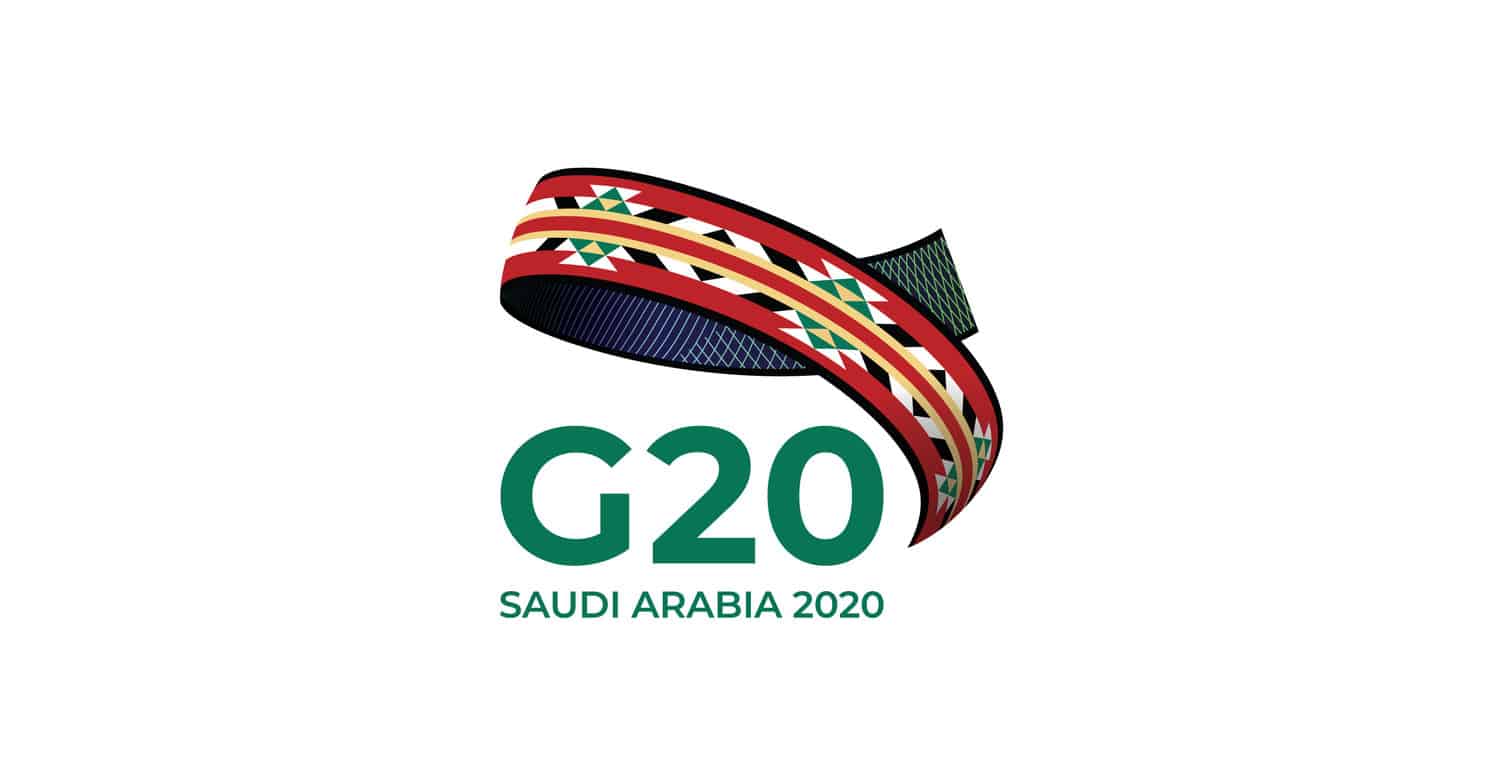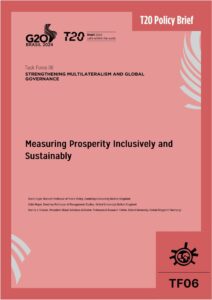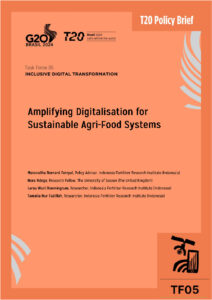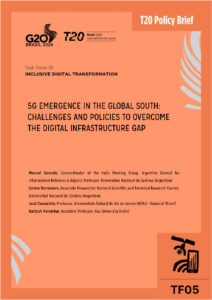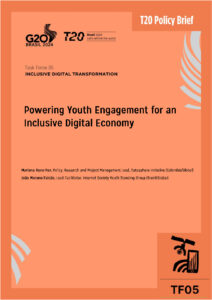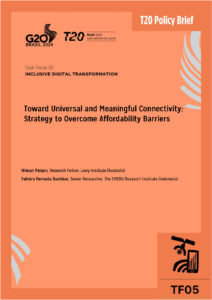The number of youths migrating is growing rapidly. In 2016, while 14.9% of internation al migrants came from low-income countries (LICs), 10.2 % were from high-income countries (HICs). Of these, 20.9% of international migrants were youths (UNESCO 2016). As there are more young people on the continents of Africa and Asia currently than ever before and the numbers are increasing, this trend is likely to continue. Subsequently, the Group of Twenty (G20) has recognized the need to develop policies for youth migration. The Think Twenty (T20) was instituted to formulate policies to guide the movement of youths by 2050. The group proposed to investigate youth migration by adopting a critical realist approach within a qualitative domain. The critical realism aspect of the study will help understand the cause of youth migration. Data collection for the study will be centered on two countries with high levels of youth migration: Nigeria (the most populated country in Africa) and Pakistan (the fourth most populated country in Asia).
Challenge
Statistically, compared to other countries in Africa, youth migration from Nigeria is high due to the country’s large population of approximately 200 million (Worldometers 2020). Similarly, the number of youths that are migrating out of Pakistan compared to other countries in Asia is also high. The two countries are categorized as LICs, and therefore, there is a need for the Think Twenty (T20) to develop policies to guide youth migration from LICs. While the appropriate policy formulation is suggested in this paper, empirical research on causal effects and efficiency of education policies targeting youth migrants is limited. However, early intervention appears to be the most efficient strategy to advance effective educational outcomes at both the receiving and origin countries and effective integration into the labor markets and the society of the receiving countries. This paper examines the trends in global youth migration in Africa and Asia with the intention of testing the outcomes in other G20 countries to understand the causes of youth migration and develop effective immigration policies. Securing residence status, developing labor market policies that remove employment barriers, and planning to prevent racial and ethnic segregation may help create sustainable educational outcomes for youth migrants.
According to Population Action International, 62 countries are considered “very young” with two-thirds of their populations under the age of 30 (and less than 6% are above the age of 60) (PAI 2019). The countries that fit this profile include Nigeria, Afghanistan, and Pakistan. Of great concern is the fact that some international students and graduate migrants experience social exclusion (Fayomi 2013). Support systems for international students are limited in terms of their effectiveness and their ability to provide integration into the labor market. This gives rise to questions such as: Is the education that is acquired by young migrants mutually beneficial to students and employers in origin countries? Do destination countries benefit from the contributions of graduate migrants? Do graduate migrants integrate into the labor market and the society at large more than non-graduates?
Proposal
As the primary goal of the Think Tank (T20) has been to develop concise and evi dence-based policy recommendations to enable a broader vision in directing policy-making processes, enhancing quality and standards is key to ensuring that education is mutually beneficial for origin and destination countries. This policy brief emphasizes the international collaboration that is required for cross-border higher education and technical training, including defining terminologies and unifying criteria for regulatory frameworks to ensure that qualifications are recognized in origin and destination countries. International dialogue and collaboration are essential for defining the standards that can be mutually recognized. Inclusion of international students’ migration issues in all relevant aspects of government, particularly development plans and policies of home and destination countries are also essential. Additionally, a comprehensive migration governance agenda that incorporates G20 students’ migration into G20 policies and reflects international human rights needs to be established. For any planned development action, impact assessments on the implication of migration must be conducted. Therefore, the study also recommends the provision of self-sustaining skills and opportunities for youths and the establishment of policies and programs that encourage global education in both origin and destination countries. Positive cross-border and cross-generational activities must also be encouraged among youths as opposed to irregular migration and undocumented migration.
Relevance to the G20
The G20 is a pertinent forum for this policy brief because of its alignment with the migration dynamism in the internationalization of education. T20 Track 9 emphasizes Migration and Young Societies, and this reflects the importance of the G20 agenda to address global challenges to pursue a sustainable, inclusive, and resilient society.
Methods
This brief is based on critical realism (CR), as a realist philosophy that claims that reality exists independent of the policymaker’s insights and that only some facets of this world are precisely explicable via the policymaker’s senses of them (Bhaskar 1998). Policymakers’ acquaintances are not always reliable because, for example, policymakers can be misled by impressions and misinterpret logic as facts. Nevertheless, when a policymaker misrepresents an event, the properties and occurrence of that event are impartial to their perception and understanding. However, as reality is independent of policymakers’ senses, the cause of the event still functions even if they are not aware of its operation. That is, formulating a policy for youth immigration should be a function of understanding their reasons for migrating without making assumptions based on encountered problems.
The reason for CR is to uncover the cause of an event; that is, why do youths migrate from origin to destination countries? This will provide a broad understanding of the motive of the youth migration. This is because formulating policies to solve the problems encountered due to migration will mean that the policies are proposed to solve a problem that it does not create. Therefore, assessing the impact of global education on youth immigration and the investigation of the root cause of youth migration will help develop the best fit policy for the T20.
The realist believes that intransitive entities are independent of policymakers; that is, the reasons behind policies, such as “structures, mechanisms, and real things, (such as events, possibilities, and processes) of the world” are real (Bhaskar 1978, 22). The reality of an intransitive entity does not depend on a policymaker’s knowledge or perception. Transitive entities, on the other hand, are models, theories, methods, and paradigms. These entities’ presence is reliant on human activity, and they are personal (transitive entities would stop if people unexpectedly ceased to exist). These differences between what happens and what we perceive between the causal and an event (but feasibly unobservable) mechanism that caused the event are the main qualities of CR that policymakers need to explore. The event, in this case, is to investigate the impact of global education on youth immigrants from the selected countries.
Social Exclusion and Migration in Africa and Asia
The concept of social exclusion is relatively recent. It gained currency in the European context in response to rising unemployment and income inequalities that characterized the closing decades of the twentieth century, a period of considerable economic and social dislocation as countries sought to deal with the challenges of globalization on their labor markets, welfare states, and prevailing ideas about citizenship.
Social exclusion according to Kabeer (2005) is a process by which certain groups are systematically disadvantaged because they are discriminated against based on their ethnicity, race, religion, sexual orientation, caste, descent, gender, age, disability, HIV status, migrant status, or where they live. Discrimination occurs in public institutions, such as the legal system or education and health services, as well as social institutions like the household, and many women and girls are socially excluded.
In all societies, some groups are socially excluded. However, the groups affected and the degree of discrimination vary from one society to another, as do the forms that social exclusion takes. In one context, discrimination against women may pose the greatest development challenge; in another, it might be racial discrimination. Addi tionally, people who suffer discrimination on various fronts—for instance, disabled older women from ethnic minorities—are often the poorest (Davis 2003).
International Migration is defined according to Fayomi (2013) as the movement of people across country (and state) boundaries and between countries to establish a new place of residence. Since the beginning of the second millennium, the importance of international migration and the implications at economic, social, cultural, political, and demographic levels have been a burning issue (Friedman 2005). Thus, in 2010, 214 million migrants were recorded worldwide, which was 3.1% of the world population (World Bank 2011). Africa has largely contributed to this phenomenon because, in 2000, out of the 175 million migrants, 16.2 million were from Africa. In the same year, there were 3.6 million refugees and 9 million displaced people in Africa. Sub-Saharan Africa contributes to this global world movement but distinguishes itself by the predominance of the regional characteristics of the migrations.
The importance of regional migration resulted in political measures and the adoption of legal provisions to minimize the risks, such as the Common Migration approach adopted by the Economic Community of West African States (ECOWAS) Member-States in January 2009. (Trémolières and Turko 2009). The growing interest in international migration issues is also expressed through the increasing attention given to migrants’ monetary transfers (Fayomi 2013). Although the importance of economic flows represents a potential source of development funding, especially in countries of origin, the means and modalities of transfer, how these amounts of money are used, and the solutions to improve their effective contribution to development must still be explored (Fayomi 2013).
Internationalization of Education in Africa and Asia
Knight (2006) posits that internationalization is a two-way street—students move largely from south to north, for example—and serves important needs, such as economic and social development. However, the global north largely controls the process.
International higher education initiatives exist in almost every country, but HICs—especially the English-speaking nations and, to a lesser extent, the larger EU countries— provide most of the services. By any measure—such as flows of international students, franchisers of academic programs to foreign providers, international accreditors or quality guarantors, or controlling partners in “twinning” arrangements—these countries reap the main financial benefits and control most of the programs (Knight and de Wit 1997).
The “buying” countries are Asian and Latin American middle-income countries and, to a lesser extent, LICs such as Nigeria that lack the capacity to meet the growing demands of higher education programs (Knight 2006). The largest markets are, therefore, for demand-absorbing programs that provide access to students who could not otherwise attend a postsecondary institution. Government policies favoring particular ethnic groups may also influence demand, such as in Malaysia (Knight 2006). The less prestigious end of the higher education system offers most demand-absorbing programs. Foreign providers—almost always aiming to earn a profit—may link with local entrepreneurs or public or private academic institutions or may establish their own campuses.
Top European and American institutions have opened branch campuses at the invitations of the governments of Singapore and Qatar, and the University of Chicago established a business school in Spain. Their degree programs may include home campus or entirely offshore studies. The market for international higher education initiatives thus ranges from students who cannot obtain access at home, to carefully targeted elite students in small, high-quality programs.
Another part of the market contains undergraduate students seeking an overseas academic or cultural experience (Altbach 2004). Although predominantly an American phenomenon—175,000 US students go to other countries to study—other industrialized countries also send significant numbers of students abroad, often via EU programs (Garrett 2004). Another widespread phenomenon in industrialized nations— providing effective cross-cultural educational preparation for university students, such as internationalizing the curriculum—accompanies the physical movement of students, programs, providers, and academic staff across borders (Kirp 2003).
Africa, with the partial exception of South Africa, demonstrates the fewest international and cross-border initiatives. The private Universiteit Nienrode (Netherlands Business School) recently established a branch campus in Nigeria in partnership with the African Leadership Forum, a nonprofit organization founded in 1988—one of the first cross-border initiatives on the continent outside of South Africa. Kenya is home to two private nonprofit universities. Pakistan’s Aga Khan University opened a branch university campus in Kenya in 2002 that specializes in nursing education, and Alliant International University (US) provides education in Social Sciences and the Humanities. The number of foreign programs offered in South Africa has decreased because of strict new government regulations and accreditation processes. Only a few foreign institutions have branch campuses, including Bond and Monash from Australia, DeMontfort (United Kingdom), and the Netherlands Business School. Three foreign institutions are leaving because of accreditation issues related to a recent review of MBA programs. Monash will remain (it does not offer an MBA program), as well as the British-based Henley Management College, primarily a distance provider.
Singapore institutions are also noteworthy exporters. The National University of Singapore and Fudan University developed a joint MBA, aimed at Chinese and Singapore students. The National University is also embarking on a new graduate school initiative for Chinese students to be located in Suzhou Graduate Town, part of the Suzhou Industrial Park. Raffles LaSalle Limited is a publicly-traded Singaporean company that provides programs in fashion and design in many Asian countries.
India’s higher education sector imports and exports programs and services at an unprecedented pace. One initiative is the partnership between the Caparo Group—a UK firm with interests in steel, engineering, and hotels—and Carnegie Mellon University (US) to set up a new campus in India.
Implications
Internationalism will remain a central force in higher education, although its contours are unclear. Australian experts argue that perhaps 15 million students will study abroad by 2025—up from 2 million in 2005 (Bhalla 2005). This prediction might be optimistic. However, the international student numbers in Australia have declined somewhat, after a decade of dramatic expansion. The US, the leading host country, also saw a modest enrolment decline in 2004 (Knight 2006). The long-term trends are strong and stable, but several uncertainties may affect the pace of internationalization:
- Political realities and national security. Terrorism may affect international higher education. Tightened visa requirements in the US and other countries, security restrictions on the subjects that can be studied, and fear of terrorism expressed by potential international students may affect cross-border student flows.
- Government policies and the cost of study. Policies concerning the cost of tuition and fees for visas and other documents may affect international initiatives.
- Expanded domestic capacity. Interest in studying abroad or in enrolling in international programs may decline as countries increase access to higher education, especially for masters and doctoral programs.
- The growing use of English as a medium of research and instruction, especially at the graduate level, may stimulate interest in international programs offered by universities in English.
- E-learning. International acceptance of degrees will lead to an expanded role in distance education, especially as the Covid-19 pandemic has redefined the way things are done globally, making online businesses the new normal. However, it is unclear whether international e-learning degrees will become more widespread or domestic e-learning programs—often located in developing or middle-income countries—will continue to dominate.
- The private sector. Private higher education is the fastest-growing segment of higher education worldwide, although only a small part of this sector is international. It is not clear if private higher education providers will find the international market sufficiently profitable—although some expansion seems likely (Altbach and Knight 2007).
- Quality assurance and control. Quality assurance, a major concern, is a greater problem internationally (Adetunji 2015). Observers criticize many international higher education programs for low standards but fail to identify measures of quality.
Although positive attention has been given to the internationalization of higher education—with the process having many benefits for higher education—severe risks, challenges, and controversies are part of this multifaceted and growing phenomenon. In many countries, a series of discussions have been taking place regarding the directions, as well as the positive and negative aspects. In these discussions, it has been pointed out that too many efforts have primarily favored universities in HICs while doing little to promote long-term advances for LICs. The International Association of Universities (IAU) Survey (2005, as cited in Knight 2006) indicated that internationalization is beneficial to higher education. However, approximately 70% of the sample suggested that significant risks are associated with the international dimension of higher education.
It is important to note that most of the countries identified commercialization, brain drain, and low-quality education as the major risks associated with the internationalization of higher education (Knight 2006). Moreover, each of these risks relates more to the cross-border aspects of internationalization than campus-based activities. One of the salient motives highlighted by Knight (2006) behind internationalization efforts is the profit motive, as many universities see international efforts as a way to attract revenue to balance their budgets. Universities in HICs are establishing branch campuses, but the profit from these branches is returned to the main campus. In other words, these branches impose high fees on students in LICs to finance developed institutions in HICs. As the stakes increase, pursuing goals that are more commercial than academic in the long run, comes at a cost. Eldick (2011) posits that this internationalization is unlikely to create improvements in the quality of higher education.
The loss of cultural or national identity, homogenization of international curriculum, and brain drain are threats that are inherent in the internationalization of higher education. It is important to note that these campuses serve as a threat to the cultural values of the host society. According to Knight (2006), the loss of cultural identity is the most significant risk factor attached to the process of internationalization. Moreover, the internationalization of the higher education system is widening the gap between the socioeconomic classes and discriminating against students from LICs.
Recommendations
Higher education institutions are the essential actors in creating well-balanced and constructive internationalization strategies. Thus, they must advocate for policy change at the governmental level that drives internationalization to serve long-term academic purposes. In this regard, the most important and on-going task for all higher education stakeholders remains the continuous examination and evaluation of the effects of internationalization. It includes examining the impact of more internationally open programs, classrooms, and institutions on students.
Furthermore, the internationalization of higher education should not just be a mere paper agreement. Governments should emphasize on the quality—and quality assurance—of higher education processes, activities, and programs given that such collaborations require proper checks and balances, at both ends, by various stakeholders.
Disclaimer
This policy brief was developed and written by the authors and has undergone a peer review process. The views and opinions expressed in this policy brief are those of the authors and do not necessarily reflect the official policy or position of the authors’ organizations or the T20 Secretariat.
References
Adetunji, Adeniyi T. 2015. “Quality Issues: Beyond the Nigerian Institution.” International
Journal of Research Studies in Management, 4 (2), 3–13.
Altbach, Phillip G. 2004. “Globalization and the University: Myths and Realities in An
Unequal World.” In The NEA 2005 Almanac of Higher Education, edited by the National
Education Association, 63–74. Washington, DC: National Education Association.
Altbach, Phillip G., and Jane Knight. 2007. “The Internationalization of Higher Education:
Motivations and Realities.” Journal of Studies in International Education, 11
(3–4), 290–305.
Bhalla, Veena. 2005. “International Students in Indian Universities.” International
Higher Education, 41, 8–9.
Bhaskar, Roy. 1978. A Realist Theory of Science. Hassocks, The Harvester Press Ltd.
Bhaskar, Roy. 1998. The Possibility of Naturalism: A Philosophical Critique of the Contemporary
Human Sciences: 3rd ed. London: Routledge.
Davis, Todd M. 2003. Atlas of Student Mobility. New York: Institute of International
Education.
Fayomi, Oluyemi O. 2013. “The Diaspora and Nigeria-Ghana Relations (1979-2010).”
PhD diss., College of Development Studies, Covenant University, Ota, Nigeria.
Garrett, Richard. 2004. The Global Education Index, 2004 Report. Observatory on
Borderless Higher Education. London: Association of Commonwealth Universities.
Kabeer, Naila. 2005. “Social Exclusion: Concepts, Findings, and Implications for the
MDGs.” Paper prepared for DFID Strategy Paper on Social Exclusion.
Kirp, David L. 2003. Shakespeare, Einstein, and the Bottom Line: The Marketing of
Higher Education. Cambridge, MA: Harvard University Press.
Knight, Jane. 2006. Internationalization of Higher Education: New Directions, New
Challenges. The 2005 IAU Global Survey Report. Paris, France: International Association
of Universities.
Knight, Jane, and Hans de Wit. 1997. Internationalization of Higher Education in Asia
Pacific Countries. Amsterdam: European Association for Internationalization Education
Publications.
Population Action International (PAI). 2019. Accessed December 15, 2019. https://pai.org/publications.
Trémolières, Raymond, and Anton Turko. 2009. “Options and Market Forecasting.”
Journal of Internet Banking and Commerce, 14 (3), no.3.
UNESCO. 2016. Youth and Migration. Youth Issue Brief. https://www.un.org/esa/socdev/document.
World Bank. 2011. World Bank Migration and Remittances Factbook. https://go.worldbank.org/QGUCPJTOR0 on 2/2/2020.
Worldometers. 2020. “Countries in the World by Population (2020).” Accessed August
8, 2020. https://www.worldometers.info/world-population/population-by-country.


